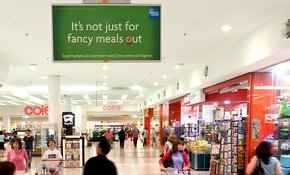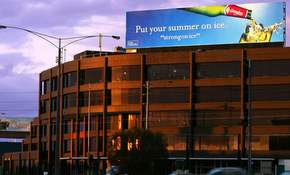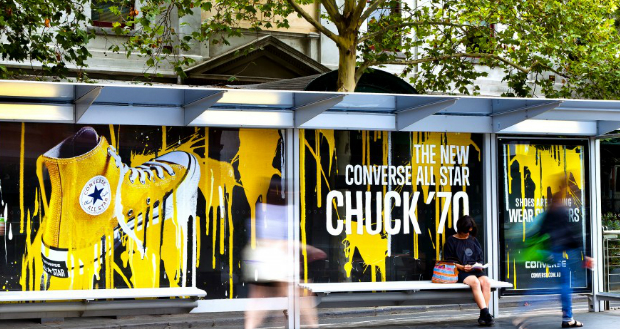
Fact: outdoor has been one of print’s best performers. But every sector of the media is under the cosh at present, and nowhere is it truly safe. As if to prove this point, on the day ProPrint meets Richard Herring in Pyrmont, Sydney, news has just come out that APN Outdoor’s next-door neighbour, Channel 10, is set to cut a hundred jobs. It is not just the telly being affected; workers from the TV network’s outdoor subsidiary, Eye Corp, are said to be included in the redundancies.
Herring knows a thing or two about the squeeze on media. As well as his role as chief executive of the country’s biggest outdoor media company, he also heads up the group’s $128m radio business, Australian Radio Network, which includes the Classic Hits and Mix stations.
The wider APN group operates in newspaper and magazine publishing via its Australian Regional Media arm and New Zealand Media across the Tasman. In fact, with the exception of television, APN has a big stake in most media segments.
In the new online reality, the media rulebook is being rewritten on a daily basis. Print media in particular is facing a dramatic correction, driven by the downturn in ad spend and fragment-ation of audience. APN has a lot at stake, with $850m of business in out-of-home, magazines and newspapers. But while print publishing is being shaken to its core, outdoor is different.
Herring says: “Of all media, outdoor is less threatened. Most media are being challenged by fragmentation of audience, therefore, the value that they offer [is being threatened].
“But the sign on the side of the road has more people going by every day than ever before. There are probably fewer billboards than there were five to 10 years ago, though they are probably bigger and better ones. The pure environment of what we do lessens the impact from fragmentation and alternative media opportunities.”
In other words, television shows and magazine articles can shift online to PCs, smartphones and tablets. Billboards can’t.
Outdoor now also trumps some media types in terms of audience metrics, thanks to big changes in the past year.
The squeeze on marketing budgets means advertising execs are under immense pressure to show clients they are getting return on investment. Internet advertising is the poster child for this kind of detailed data, with real-time feedback on who is clicking, when and even why. Print struggles compete. But thanks to some major investments by outdoor organisations, the Australian outdoor sector now punches above its weight in terms of audience measurement. The newly established audit system is called MOVE (Measurement of Outdoor Visibility and Exposure). It uses dark arts, or at least some complicated science, to figure out who is looking at ads. The system has galvanised the sector, enabling the likes of APN Outdoor to take the fight to the internet and TV.
MOVE does not help advertisers see a return on their spend; it just lets them track it. There’s a lesson here for other types of printed marketing, such as direct mail, which are suffering as spend shifts online, often because they can’t prove their impact on consumers.
“MOVE has been fantastic, but what MOVE and other audience measurement provide is indicative numbers of the reach and frequency of a campaign. That doesn’t give an advertiser a result; it increases their comfort levels and certainty around gaining a results,” says Herring.
Even without MOVE, the sector has been in rude health. Recent Outdoor Media Association figures show out-of-home upped revenues by 5.5% to $112m for the first quarter of 2011. This followed 2010 full-year figures that put growth at 19%, up to $477m for the 12 months.
Which media operator or publisher wouldn’t love to crow about figures like that? They are the kind of uplifts most commercial printers would kill for but few have seen for a long time.
Some wide-format printers have had tickets on the outdoor gravy train, but it’s unlikely any of them have been riding in first class. Even speaking to Herring, who is a few steps removed from the grubby business of haggling over the price of print, there is no message of bumper opportunities in outdoor printing. The sector is still hard graft. Like everywhere else in the printing industry, overcapacity has taken it toll on margins, he says.
“I remember when I first got into outdoor about 15 years ago. For a supersite skin, there was one manufacturer and they cost $6,000. Now you would pay around 20% of that,” says Herring.
“That is mainly through efficiencies, but there was just less competition back then. There was less knowledge of price competition. Now the market is competi-tive; there are many people who are willing to supply. When there is gap in the market, in any market, and someone is making a good margin, that’s when competition steps up and equalises that.”
Like elsewhere in the print industry, overcapacity of supply is eating into margins from the bottom up. But outdoor has a saving grace: falling volumes are not taking such as big bite from the top down. Outdoor can’t be turned off, which is its USP in the endless babble of media noise that surrounds us day in and day out. For that reason, it is weathering the storm while other print types get battered.
“Outdoor plays a really important role, which is this more ‘push’ advertising. One of the great features of outdoor advertising is you can’t turn it off. When you walk or drive past it, it is there. You can’t opt-in or opt-out,” says Herring.
By its very nature, outdoor is big and loud and in your face. The rest of the printing industry has been moving toward more targeting and personalisation, but it’s unlikely this trend will drastically alter the shape of your typical billboard or POS display. That said, outdoor advertisers still want to some targeting.
“No advertiser I know has a target of all people. Most of them have a relatively narrow target audience,” says Herring.
He points out that APN Outdoor has everything from roadside billboards to internal bus advertising to “cross-track” advertising on railway lines to airport advertising and in-store advertising.
While the variable-data aspect of digital printing is never going to be a major drawcard for outdoor advertisers, digital printing has been one a major driver of change. The move to digital – largely inkjet – has driven down costs. Herring says that the rise of digital printing has also offered gains in delivery times, quality and flexibility.
“Cost is the most important factor in our more cost-conscious world, and certainly timing as well. Campaigns can be printed much quicker than before with less preparation and less printing time. Of all the qualities of a campaign, [the rise of digital printing] satisfied most of them.”
Like all clients, those in outdoor demand the double-edged sword of shorter lead-times but quicker results. Digital printing helps here, but so does electronic media. The short-turnaround wide-format market has a rapidly emerging rival from the world of pixels.
Digital screens have been cropping up at high-value outdoor sites for years, and they are not going away. Taking off our ProPrint hat (and ignoring all those pesky issues such as power consumption and cost of investment), it’s easy to see why screens could drive a wedge between ad spend and print. But Herring says all is not lost – yet.
“What digital screens will bring to an advertiser is immediacy, in that they can literally send a PDF and we will have it up straight away. It brings flexibility to an advertiser, so McDonalds could do a breakfast deal in the morning and a drive-thru deal at night.
“But if the question is ‘will it take over from outdoor print?’, I don’t think I will live long enough to see that. If anything, I think digital introduces new clients to outdoor. Many of the our clients using digital are not ones who traditionally use outdoor.”
Resumé
Age 51
Born Melbourne
Family Wife, two children
Education MBA, Monash University
Career history
2008–present: group radio & outdoor CEO, APN; 2003-08: CEO, APN Outdoor; 2001-03: CEO, CODY Outdoor (APN owned); 1998-2001: CEO, CODY Outdoor; 1995-98: sales director, CODY; 1990-95: sales manager roles, Austereo; 1987-90: group sales manager, AMM/Network Ten; 1986-87: TV buyer, Ogilvy & Mather, London; 1981-86: various TV sales roles
Hobbies Playing the piano and looking at outdoor billboards
Richard Herring on…
Advertisers’ understanding of the print process
What they are looking for is quality, delivery and consistency. I would not expect them to understand the technical side of it. That is why we play the role we play.
Downsides to screens
Would you put a very expensive LED panel low to the ground anywhere in Sydney? Probably not, with the number of spray cans and hammers out there.
Measuring ROI
The reason that outdoor didn’t have an audience measurement system was not for a lack of want. It was the incredible complexity of
creating a robust and acceptable measurement system. That is a very large task. But if you miss it, do you miss some tricks? Yes you do. If you can bring more surety, more comfort and ultimately more results to an advertiser, you will benefit.
How to regulate racy ads
Every media is confronted by the same issue. These are difficult judgements sometimes. But it is good to keep it in context. As the Outdoor Media Association puts it, for 99.98% of campaigns there are no problems.
Comment below to have your say on this story.
If you have a news story or tip-off, get in touch at editorial@sprinter.com.au.
Sign up to the Sprinter newsletter



